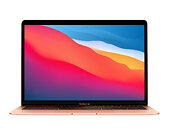Thursday, November 12th 2020

Apple's M1-Based MacBook Air Benchmarked
When Apple announced that they are going to switch their Mac lineup from Intel-based x86 processors to the custom "Apple Silicon," everyone was wondering how the new processors will look and perform. To everyone's luck, Apple has just a few days ago announced its first Apple Silicon custom processor for MacBook. The M1, as the company calls it, is their first processor designed for higher-power and performance tasks The M1 features eight CPU cores (four high-performance and four-high efficiency) paired with eight cores dedicated to the graphics. On the die, there is also a 16-core neural engine made to accelerate machine learning tasks found in the new applications.
Today, we are getting the first GeekBench 5 CPU benchmarks that showcase just how far Apple has come with its custom design. What we have is the M1 processor found in MacBook Air. This Mac model features a passive cooling system, cooling a CPU with a base frequency of 3.2 GHz. The system scored 1719 points in the single-core result, and 6967 points in the multi-core result. The single-threaded results measure itself with some of the highest-end offerings from Intel and AMD, while the multi-threaded results are very good given the mix and match of small and big cores.
Source:
GeekBench 5
Today, we are getting the first GeekBench 5 CPU benchmarks that showcase just how far Apple has come with its custom design. What we have is the M1 processor found in MacBook Air. This Mac model features a passive cooling system, cooling a CPU with a base frequency of 3.2 GHz. The system scored 1719 points in the single-core result, and 6967 points in the multi-core result. The single-threaded results measure itself with some of the highest-end offerings from Intel and AMD, while the multi-threaded results are very good given the mix and match of small and big cores.


117 Comments on Apple's M1-Based MacBook Air Benchmarked
Linux and Windows version use LLVM/CLANG 9.0, while on Apple LLVM/CLANG compiler used is v12, that's yet to be released.
SPEC is an industry standard for a reason.There is a raytracing subtest in SPECfp (povray). Should correlate well with blender.
Then on top the x86 to ARM 32 bit is going to be axed soon, Apple hates backwards compatibility a lot. And no more Virtualization, the CPU is not having VM at all, and no eGPU as well, which brings even more haziness to the equation. Add heavily soldered platform, no more repairs at all, mega BGA garbage. Apple cleverly moved away from x86 by gating the Software behind their walled garden. No Phoronix tests, no real world tests are possible at all, some crappy browser benchmark.
All that SPEC scores are useless to measure the real world performance, AT benches the 5950X top of the line CPU with that tool and gets 50W power consumption on a single thread. There are no benches for rest of the CPU threads and cores at all, same for Apple chip only 1 big Firestorm core, rest are not at all benched how can we when the tool itself is only for that purpose. And if we look at A13 benchmarks the old articles also show same "reaching desktop territory" yet there was no software to show it nor the HW top rank in the Android vs Apple pricing (more on this pricing below). Now the Cinebench came with R23 for M1 support, will show some proper synthetic bench than these useless SPEC and GB. Still I'd like to see how the CPU performs with RPCS3 emulation can it even handle ? And how the Blender like workload behaves on the same CPU, add more benchmarks like high FPS gaming too, & other software productivity tools like MATLAB.
I will even add the more stupid tests here, consider watching those Youtube tests of iPhone vs Samsungs and Onepluses etc.. how much of the SPEC graph differs in the AT benches and then the real world performance where Application response times, execution windows for multiple apps and in game FPS benchmarks, Apple always lost. All in all this SPEC is like zooming in one part of the picture and then deciding it's the best, Plus I will even mention if the Apple iPhone CPU is very fast vs Android's Qualcomm QSDs and Exynos, Kirins why the phones pricing is similar ? On Desktop side I saw Intel getting shredded in the X299 market and Mainstream market where they slashed the prices significantly due to lack of performance vs competition, best example is Nvidia's Turing vs Ampere pricing, the performance dictates the market in consumer side, this whole fiasco of world's fastest bs claims is very stupid imho.
Guess what ? All of them have to be recompiled and updated with ARM from x86 code plus if the executable is 32bit then say goodbye in the future unless the developer updates it, also this M1 chip doesn't have eGPU output as well, meaning it won't even meet min spec for the SOTTR and BioShock 2 on Mac. Not even Adobe has software ready, it's due in 2021. And also Raytracing ? You sure, running some SPEC load on a CPU for Raytracing of all, Nvidia has 3 years of AI advancement (on the side note, Apples Siri is utter trash vs Google Assistant, Apple is lacking severely in that dept.) and still they couldn't nail the RT, AMD barely started and suddenly Apple is going to takeover them ? It's not even funny anymore.
We need actual application performance for apples-to-apples comparisons - and even then, the recompiled-for-ARM version of AfterEffects for example still won't be apples-to-apples as the x86_64 variants will be the lowest-common-denominator version that'll run on a huge range of different OSes and architectures. Still, it'll be interesting to see the Native ARM version on apple vs the Windows in like-for-like application testing.
7z performace correlates almost 1:1 with the ””syntethic”” spec compression/decompression tests. Could you be more specific on why you think that spec does not translate to real world performance? It does take some time for SW to be compiled to work natively on the new platform, but you wouldn’t buy it for productive work anyway before the SW support is there.
worthdoingbadly.com/xnuqemu3/
Mac OS will be optimized for this SOC in a way Windows/Linux can't really ever come close to and that alone already gives it a leg up.
Windows/Linux on the other hand have to work on nearly all hardware launched in the last 10 to 20 years.
Geekbench is great for different OS and ISA comparisons, and is also not memory dependent anymore
next week there will be a lot of surprised people who have had their heads in the sand for the last 5 years
trends matter, Apple has been improving more than Intel every year for 5 years, that is why they are ahead now
Oh, you might think you can upgrade this yourself? NOPE. Everything is soldered onto the mobo.
The $899 mini is STILL the same 8Gb ram (pathetic) and 512b ssd (so basically +$200 for 256Gb upgrade)